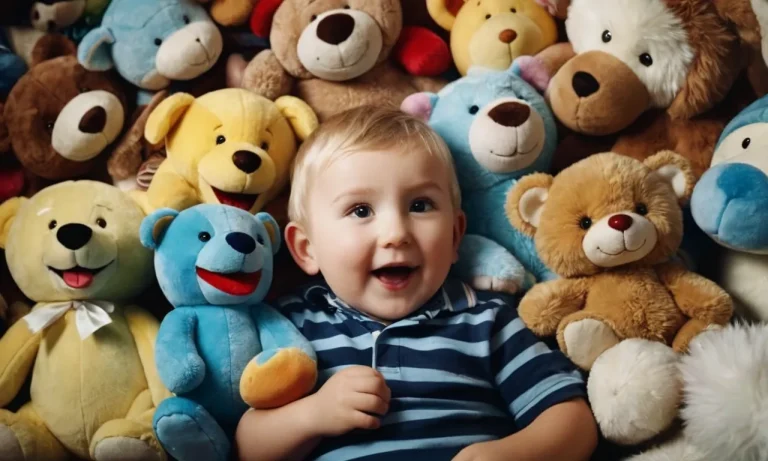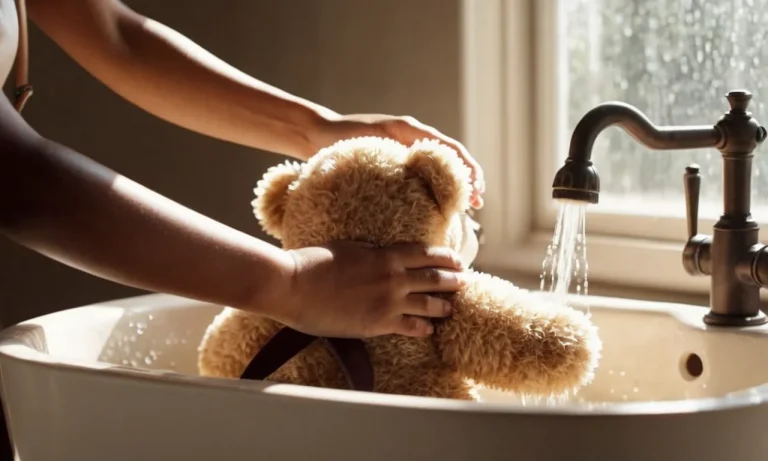Stuffed animals are beloved childhood toys for many of us, but as we grow up, they often pile up and clutter our homes. So what exactly should you do with all your plush pals? If you’re short on time, here’s the quick answer: The best approaches for dealing with extra stuffed animals are finding them new homes through donating, repurposing them into crafts or decor, passing them down to kids in your life, or selling rare collectibles to enthusiasts.
In this comprehensive guide, we’ll explore the ins and outs of the various options for clearing out or continuing to enjoy your stuffed animal collection.
Specifically, we’ll cover: how to decide if you should keep special stuffed animals or let them go, creative ways to put them to use around the house through upcycling and craft projects, tips for donating them to charity or hospital programs, recommendations for passing them on to children who will treasure them, advice on rehoming them via online exchanges or yard sales, and a look at making money by reselling collector items.
Deciding Whether to Keep Special Stuffed Animals
The sentimental value of childhood toys
Many of us form strong emotional attachments to stuffed animals and other toys from our childhood. These special toys take on meaning due to the memories and feelings they evoke. Over 75% of adults in one SurveyMonkey survey said they still have their childhood stuffed animals packed away somewhere.
Childhood stuffed animals remind us of simpler, happier times. They connect us to fond memories of playtime, joy, and imagination from when we were young. Even the sight of an old, tattered teddy bear with one eye missing can bring smiles.
No wonder so many adults find it hard to part with their precious plush pals 🧸😊.
Storing keepsake stuffed animals
Adults who want to keep cherished stuffed animals from childhood have several storage options to preserve them:
- Store in archival plastic bins with acid-free tissue paper
- Place in sealable plastic bags to prevent dust buildup
- Use cedar boxes or chests which deter moths and repel moisture
Proper storage helps protect beloved stuffed animals from damage over many years. With some care taken to avoid light exposure,pest infestations, humidity and temperature fluctuations these sentimental toys can potentially last decades–just like our wonderful memories of childhood attached to them 😍👏.
Displaying stuffed animals in your home
For those who want their special stuffed animals on display, whether from childhood or favorite collectibles, here are some creative ideas:
- Shelving unit or bookcase to nicely showcase stuffed animals
- Custom shadow boxes with mementos arranged around stuffed animals
- Repurposed curio cabinets to display stuffed animal collections
- Wall mounts, floating shelves and plate stands for individual stuffed animals
When choosing stuffed animal displays in your home, group collections by theme, color, or type for a more cohesive look. And don’t overlook lighting – spotlights or string lights enhance stuffed animals beautifully.
With a little planning, treasured stuffed animals can add warmth, visual interest and whimsy to any room’s decor 👍.
Donating Unwanted Stuffed Animals
Finding local donation centers
Looking to clean out some beloved yet unused stuffed animals? Consider donating them to charity! There are often local options that make donating stuffed animals easy.
- Check with women’s shelters, children’s hospitals, foster care facilities, and nursing homes. These places frequently accept plush toy donations to comfort those in need.
- Contact local police and fire stations about donating. Officers often keep stuffed animals handy to help calm children in distress.
- Search online for charities near you seeking stuffed animal gifts. Places like Goodwill, Salvation Army, and local donate networks often take plush donations.
Organizations accepting stuffed animal donations
Many larger charitable organizations graciously accept stuffed animal donations too. Here are some great options:
- Project Linus – Non-profit network with chapters across the US that donate blankets and stuffed animals to children in need.
- Operation Gratitude – All donated stuffed animals go in care packages sent to veterans, military, and first responders.
- Teddy Bear Coalition – Distributes donated plush toys to less fortunate children and disaster victims.
Preparing plush toys for donation
Be sure to properly clean and prepare stuffed animals before dropping them off for charity:
| Wash | Machine or hand wash plush toys to sanitize them before donating. |
| Inspect | Check for any damage or loose parts that could separate. |
| Repair | Sew up any small holes or tears before stuffed animals are played with again. |
With some spring cleaning and prep, your once-cherished stuffed pals can go on to bring joy to other children in need. Check your local donation options today!
Repurposing Stuffed Animals for Crafts and Decor
No-sew stuffed animal craft ideas
Stuffed animals can be repurposed into amazing no-sew crafts and decorations with a little creativity. Some fun ideas include:
- Making sock puppets – Simply slip your hand into an old sock and attach a stuffed animal head with hot glue or fabric glue
- Creating scene decorations – Glue stuffed animals onto popsicle sticks and use them as scene setters or puppets
- Making critter containers – Glue stuffed animal figures onto small boxes, tins, or jars to make quirky storage containers
- Decorating place card holders – Hot glue a small stuffed animal onto a marble, rock, or chunk of wood to hold place cards
- Fashioning wreaths – Attach stuffed animals, fabric scraps, and other decorations with floral wire to make unique wreaths
The possibilities are endless! Let those orphaned stuffed animals provide hours of crafting entertainment and add a playful touch to your home.
Sewing projects using plush toys
Don’t underestimate a stuffed animal’s fabric potential! With a needle and thread, you can give old plush toys new life in charming DIY sewing projects like:
- Stuffed animal pillows – Simply sew two stuffed animals together into one large pillow
- Plush backpacks – Sew straps onto a stuffed animal to make a functional backpack
- Cuddly cases – Make phone, e-reader, remote control or eyeglass cases out of stuffed animal fabric
- Snuggly heating pads – Sew a bag out of the plush exterior and stuff it with rice, wheat or flaxseed
- Cozy pet beds – Line a basket or bin with soft stuffed animal fabric for your furry friend
To find great step-by-step tutorials for projects like these, search for “upcycling stuffed animals” on YouTube or Pinterest. Get sewing and give tattered plushies new life!
Making unique home decor items
With a dab of paint or glue, those well-loved stuffed critters can become one-of-a-kind focal points around your home. Display them proudly with crafts like:
- Painted vases or pots – Coat stuffed toys with decoupage or spray paint to make decorative vessels for holding utensils, pens, flowers or plants
- Fabric lampshades – Simply stretch stuffed animal fabric over a lampshade frame
- Wall hooks or coat racks – Mount stuffed animals on wood plaques and hang on walls to hold coats, hats, keys, etc.
- Ring holders and jewelry stands – Hot glue trinkets and jewels onto larger stuffed animals positioned on shelves or desks
- Bath caddies – Affix a soap dish, loofah, and other shower accessories onto a stuffed animal form
For a foolproof way to display your upcycled creations, look for small stands, plaque bases or shadow boxes at local craft stores. With a little imagination, the possibilities are endless for reinventing stuffed animals into décor!
Passing Down Stuffed Animals to Kids
Choosing toys for hand-me-downs
When selecting stuffed animals to pass down to younger kids, durability and safety should be top priorities. Plush toys that have withstood years of love and playtime often have sentimental value that makes them special hand-me-downs.
Check that the toys have secure seams, eyes, and parts, and that the stuffing is still fully inside before gifting them.
Sanitizing used plush items
Gently washing stuffed animals in the washing machine or by hand helps eliminate dust and germs before giving to kids. Air drying thoroughly helps prevent mold growth. For toys that can’t be washed, use a disinfectant spray and allow to dry fully. A quick refresher restores toys to like-new condition!
🧼😊
Gifting stuffed animals
When surprising a child with a beloved stuffed animal handed down from parents or older siblings, capture the moment on camera! The excited and joyful reaction makes a precious family memory. Include a note with the toy telling its name, history, and any fun stories to truly pass along the significance.
Having a keepsake passed down personally often carries more meaning than store bought toys. Over time, wear and age adds character reminding of the good times had by previous owners. The next generation can create new adventures and their own memories while still appreciating old ones.
What stories might your stuffed animals tell if they could talk? 🐘🐰🐥
Selling Collectible Stuffed Animals
Researching rare and vintage plush toys
Determining if your childhood stuffed animals have collectible value requires some research. Look for tags indicating the original manufacturer, year produced, and any limited production notes. Vintage Steiff, Gund, and Ty plush toys tend to be more valuable.
Search online databases like WorthPoint to compare your items to past auction prices for identical or similar toys. Consider condition, rarity, age, tags, and any defects. The more unique and pristine the state, the higher collectibility.
Pricing collectible stuffed animals for sale
Finding comparable sales data gives a good benchmark for pricing rare plush collectibles. Resources like eBay’s completed listings provide transparent pricing insights. Consider adjusting 30-50% above the highest past sale to leave room for negotiation.
For truly one-of-a-kind specimens, consulting antique toy experts helps establish fair asking prices. List moderately above expert appraisals to allow some discount while still profiting. Regularly monitor online seller forums and groups to stay atop current trends and demand for scarce vintage stuffed animals as pricing fluctuates.
Selling platforms for collector toys
Online marketplaces like eBay, Etsy, and specialty collector sites provide exposure to seasoned toy buyers willing to pay premiums for rare finds. Local antique malls and auctions also draw enthusiasts. When selling high-dollar plush, consider secured payment services like Escrow.
Describe items thoroughly, provide detailed photos showing any wear/damage, authenticate tags/markings, and emphasize provenance details supporting collectibility and fair pricing. Leveraging enthusiast communities also allows collecting direct sales inquiries for coveted rare stuffed animals vs waiting for platform buyers.
| Selling Platform | Pros | Cons |
|---|---|---|
| eBay | Broad reach, seller protections | High fees, low price buyers |
| Etsy | Vintage focused consumers | Lower toy traffic vs eBay |
| Specialty Sites | Qualified enthusiast buyers | Narrower audience |
| Local Antique Market | No fees or shipping | Limited foot traffic |
Conclusion
With so many cuddly stuffed pals out there, it can be hard to figure out what to do with your surplus when you no longer have room. Hopefully this guide gave you some great options like repurposing them for crafts, passing them on for kids to enjoy, donating them to a good cause, or even making money off collectibles.
At the end of the day, do what feels right for you. Not ready to part with some special friends? Keep them! But for the rest you’re ready to rehome, put them to good use so they can continue spreading joy.







